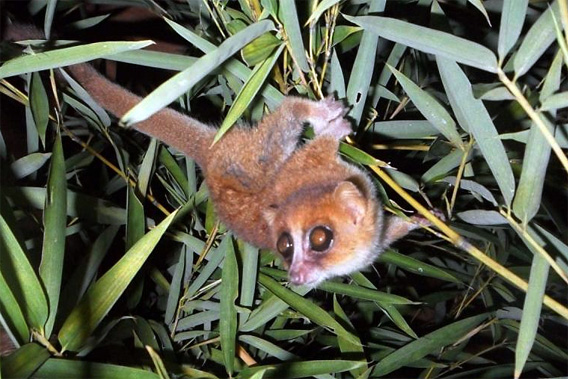Scientists have discovered two new species of mouse lemurs in Madagascar, bringing the total number of diminutive primates known to science to 20, according to a paper published in the latest issue of the International Journal of Primatology.
The lemurs were collected in 2003 and 2007 during field surveys to the eastern part of the island nation. Genetic analysis revealed them to be new species: the Marohita mouse lemur (Microcebus marohita) and the Anosy mouse lemur (Microcebus tanosi).
Both species are unusually large for mouse lemurs. Microcebus marohita tips the scales at 78 grams (2.8 ounces), making it the largest of known mouse lemurs. It reaches a length of 28 cm. Microcebus tanosi is now the second largest known mouse lemur, reaching 27 cm from snout to tail and weighing about 50 grams. It is named after the Anosy region in southeast Madagascar.

Microcebus marohita mouse lemur. Photo by Bellarmin Ramahefasoa.
Microcebus marohita is named after the forest in which it was found. The Malagasy word “marohita” means “many views”, although the researchers who discovered it warn that “despite its species’ name, this mouse lemur is threatened by ongoing habitat destruction, and ‘many views’ of its members are unlikely.” According to a statement from Duke University, much of the forest where the lemur lives has been cleared since it was originally collected.
“This species is a prime example of the current state of many other lemur species,” said senior author Peter Kappeler of the German Primate Center in Goettingen. Microcebus marohita is therefore already listed as “endangered” by the the International Union for the Conservation of Nature (IUCN).
More than 90 percent of Madagascar’s lemurs are classified as at risk. Habitat loss is the primary threat, although some species are targeted by the commercial bushmeat trade.
The pace of lemur species descriptions in Madagascar has dramatically accelerated over the past decade, with the known number of species climbing from 47 to more than 110 during that time.
The authors of the new paper say identifying lemur species is a critical step in protecting them.
“Knowing exactly how many species we have is essential for determining which areas to target for conservation,” Kappeler said.

Shaquille O’Neal, a NBA legend who retired in 2011, posed with a mouse lemur at Zoo Miami in March 2012. The lemur was on loan from the Duke Primate Center in North Carolina. Photo courtesy of Mireya Mayor.
Mouse lemurs are the smallest lemurs and among the tiniest primates in the world. They are found in virtually all of Madagascar’s forests where they feed on insects, fruit, and plant sap. Mouse lemurs are nocturnal and betray their presence with high-pitched chirps.
Mouse lemurs are of particular interest to scientists because in captivity at least one species is known to develop brain lesions similar to those found in Alzheimer’s patients. Researchers are thus studying the diet of wild mouse lemurs to see whether plant compounds can help protect against the onset of the debilitating disease.
CITATION: Rodin M. Rasoloarison, David W. Weisrock, Anne D. Yoder, Daniel Rakotondravony, Peter M. Kappeler. Two New Species of Mouse Lemurs (Cheirogaleidae: Microcebus) from Eastern Madagascar. International Journal of Primatology, 2013; DOI: 10.1007/s10764-013-9672-1